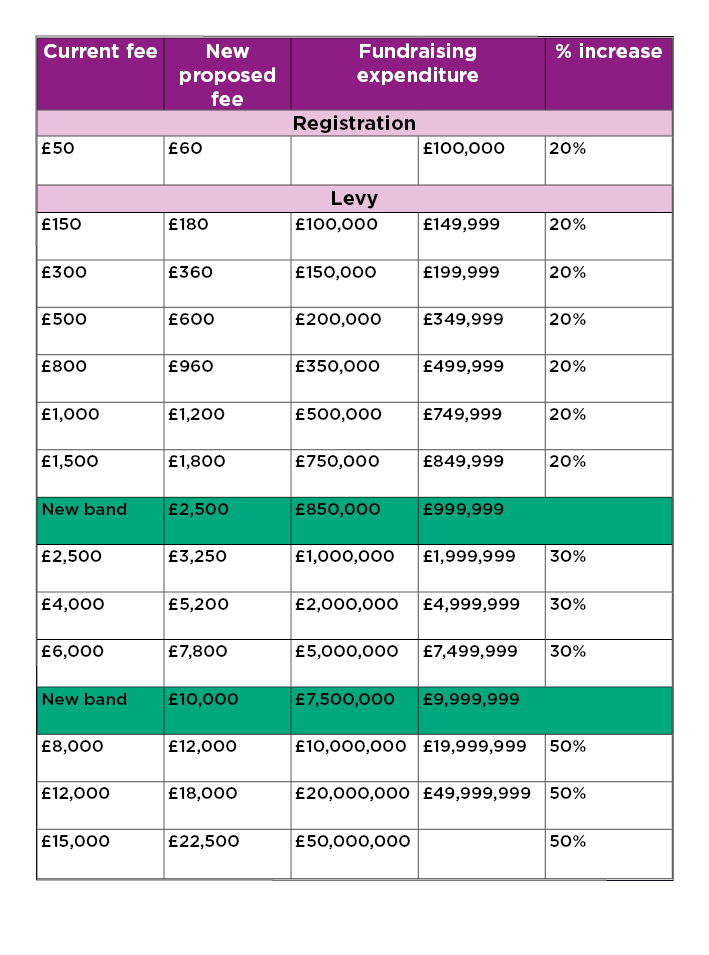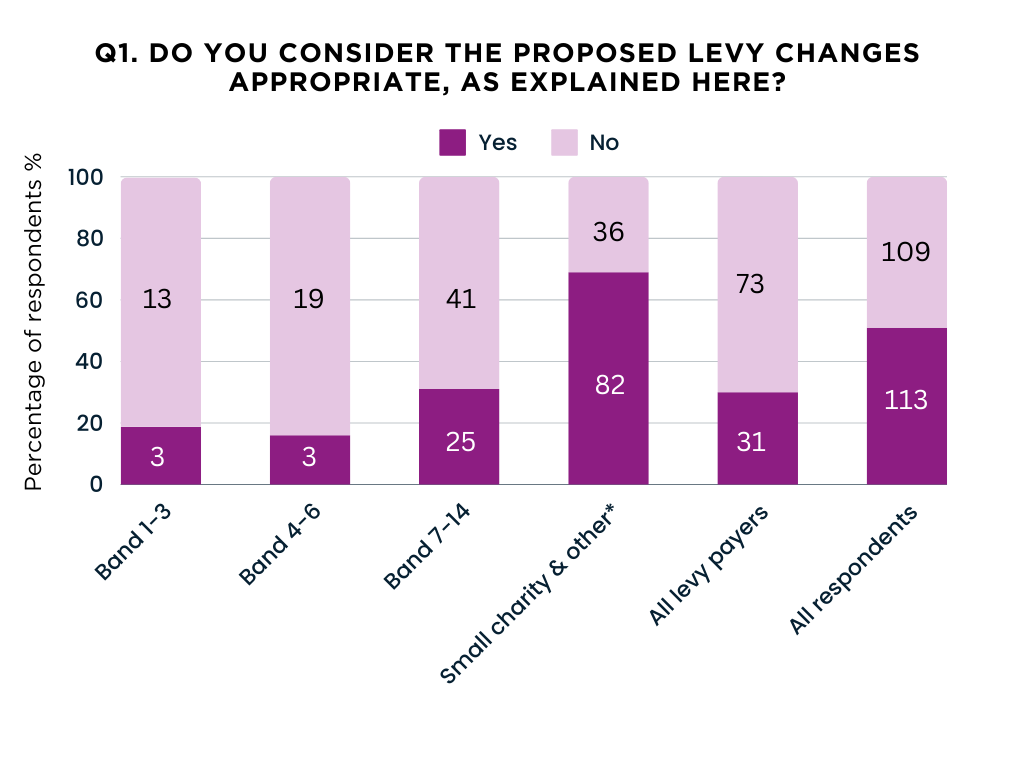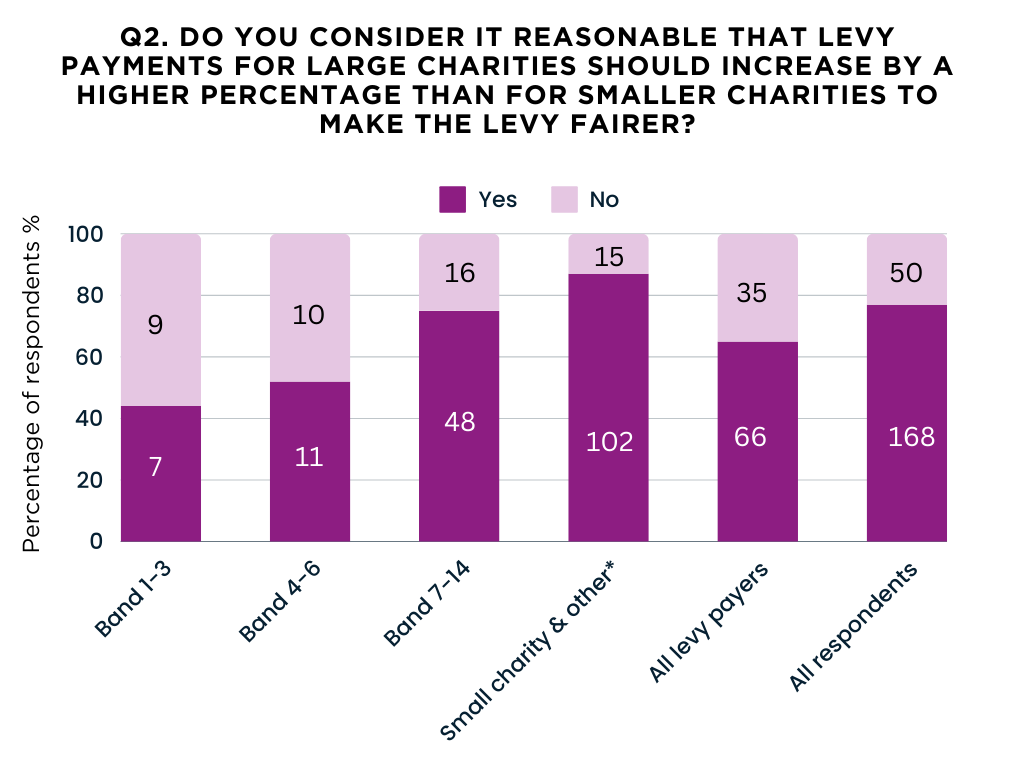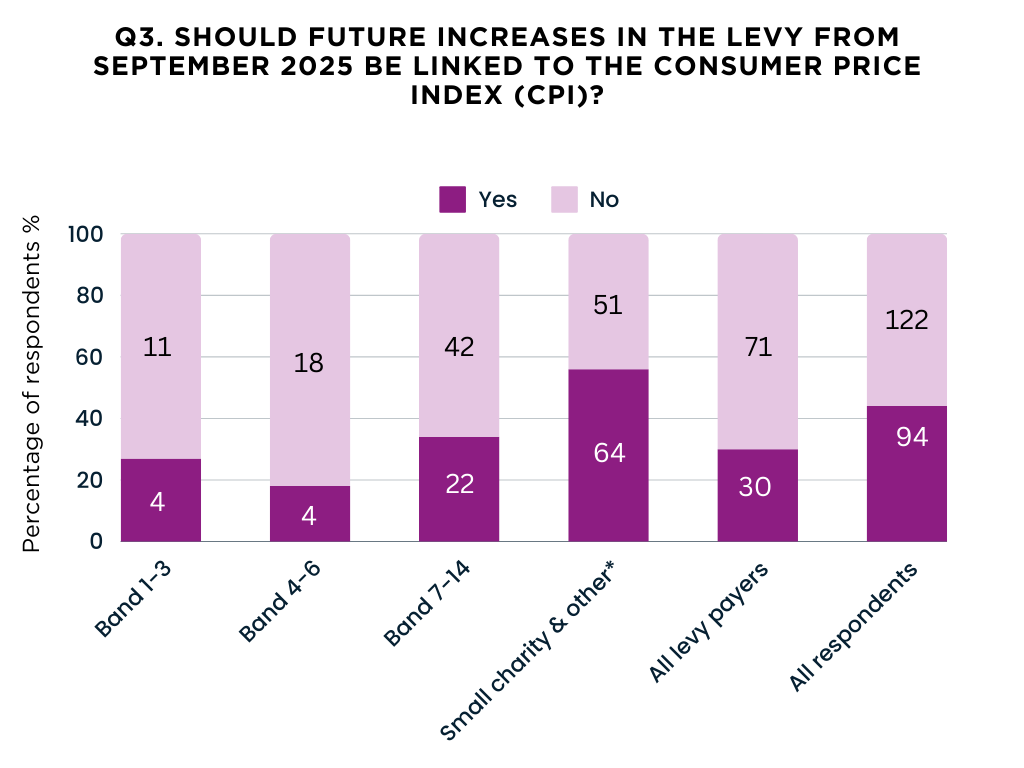Proposed funding model from our review
Each year there are around 2,000 charities covered by the levy. The levy would increase for everyone, but the more a charity spends on fundraising, the higher that percentage increase would be. Conversely, the less a charity spends on fundraising, the lower it would be.
 So, for example, a charity spending over £50 million on fundraising would be asked to pay £22,500, one spending up to £1.1million would pay £3,250, and one spending up to £350,000 would pay £600. Those in the lowest levy band would see their fee increase from £150 to £180. This means the highest-spending charities’ levy payment would rise by 50%, medium-spending charities’ levy payment by 30%, and lower-spending charities’ (which make up the majority of those registered with us) by 20%.
So, for example, a charity spending over £50 million on fundraising would be asked to pay £22,500, one spending up to £1.1million would pay £3,250, and one spending up to £350,000 would pay £600. Those in the lowest levy band would see their fee increase from £150 to £180. This means the highest-spending charities’ levy payment would rise by 50%, medium-spending charities’ levy payment by 30%, and lower-spending charities’ (which make up the majority of those registered with us) by 20%.
If we had raised rates in line with the Consumer Price Index (CPI) since 2016 the levy would currently be 25% higher for everyone.
Under this system, the top 327 registered charities would have paid a greater proportion of the entire levy. We believed this to be the fairest way to spread the cost.
We also introduced two extra bands so that the rise in levy payments would be more gradual as charities move up the payment scale.
Overall, the levy still represented a fraction of a percentage of a charity’s total fundraising expenditure. In addition, it represented an even smaller percentage of a charity’s income from donations (donated income for the top 10 largest levy paying charities in 2021/22 totalled £2.376 billion and ranged from £27 million to £426 million).
From September 2025, we intended to increase the levy by CPI each year so that future rises were more gradual, and we would let levy payers know what these will be in advance.
The levy would have also increased for commercial fundraisers and exempt charities (for example, universities in England).
Small charity registration
We proposed to increase the administration fee for small charity registration from £50 to £60 to reflect a rise in our processing costs since 2016. We would review the fee from time to time in the future, but it would not be subject to annual CPI increases to make it simple to administer.
Why we need to increase the levy
Proactive regulation
In our Strategic Plan 2022-2027 we reaffirmed our commitment to being a pro-active regulator. With this in mind, we are currently reviewing the Code of Fundraising Practice to take into account, among other things, the effect of new developments on the sector and fundraising in particular. We wanted to make sure we have adequate funding to continue to advise, support and regulate the sector during these changing times (for example through market inquiries) and we recognised that at the moment fundraising is much harder than it has been for a while.
Our Strategic Plan also sees us engaging more actively with the charities we regulate through increased capacity to learn from charity fundraising experience and share our own learning. For example, by undertaking wider inquiries or carrying out research into aspects of fundraising which will be of benefit to charities and those they work with.
We have already started this work with the market inquiry we announced in October 2023 into how charities use contracts and sub-contracts to deliver their fundraising strategies and some commissioned research into how the public views fundraising.
Caseload
As public awareness of the regulator has grown, so had our casework. Our 2020/21 annual report found that our caseload had increased by 26% over the previous two years. In addition, as fundraising methods change and more fundraising happens online, our small team has dealt with an increasing number of complex cases and sensitive issues of public concern. We wanted to make sure we have enough resources to support this work.
Online fundraising
There had been a significant rise in digital fundraising since the Fundraising Regulator was established in 2016. The ongoing growth of fundraising platforms, contactless giving and social media fundraising requires new regulatory responses and increased levels of partnership working with the sector to ensure public protection and accountability in this rapidly evolving landscape.
Economic climate
As you will know, the economic situation has continued to be challenging. As with the rest of the country over the last year, our running costs have been affected by unexpected inflation of over 10%.
Alternative ways of meeting our costs
As part of our commitment to providing value for money, we considered a variety of ways of supporting our work that didn’t involve increasing the levy.
These included:
Use of reserves
For the current financial year, we are running at a deficit using funds from our reserves. However, this is only sustainable for a maximum of two years before our reserves fall below a safe, minimum level of around six months of running costs. It is therefore not a long-term solution.
We keep a reserve fund of around £1.5million to cover around six months of operating costs. The balance of our current reserves (around £500k) is held in order to support legal costs in case any of our decisions are challenged in court. As a voluntary regulator we are limited in the legal insurance cover we can rely on.
Making savings
In 2021/22, we made savings by cutting the cost of the Fundraising Preference Service from £260,000 to £148,000 a year, a percentage reduction of 42.5%. However, we believed the scope for us to make further spending reductions through efficiency savings is limited. We have a small team of around 30 people and benchmark pay rates against a range of other bodies in the regulatory, public and charity sectors. This is carried out by independent specialists. In the last few years, we have moved to a more flexible way of working with fewer desks in an office to reduce the cost of accommodation. All this with a view to making sure we provide good value for money.
Relying on growth of fundraising expenditure
While we thought that inflation is likely to increase fundraising expenditure and therefore levy payments over the next few financial years, we considered that these increases would be slow. Unfortunately, the growth of fundraising expenditure is unlikely to provide the additional funding we needed to enable us to remain an effective regulator.
 So, for example, a charity spending over £50 million on fundraising would be asked to pay £22,500, one spending up to £1.1million would pay £3,250, and one spending up to £350,000 would pay £600. Those in the lowest levy band would see their fee increase from £150 to £180. This means the highest-spending charities’ levy payment would rise by 50%, medium-spending charities’ levy payment by 30%, and lower-spending charities’ (which make up the majority of those registered with us) by 20%.
So, for example, a charity spending over £50 million on fundraising would be asked to pay £22,500, one spending up to £1.1million would pay £3,250, and one spending up to £350,000 would pay £600. Those in the lowest levy band would see their fee increase from £150 to £180. This means the highest-spending charities’ levy payment would rise by 50%, medium-spending charities’ levy payment by 30%, and lower-spending charities’ (which make up the majority of those registered with us) by 20%. 


